-
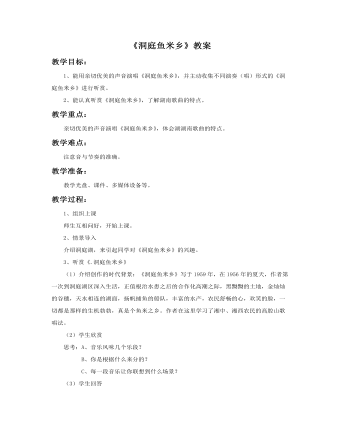
《洞庭鱼米乡》教案
教学过程:1、组织上课师生互相问好,开始上课。2、情景导入介绍洞庭湖,来引起同学对《洞庭鱼米乡》的兴趣。3、听赏《.洞庭鱼米乡》(1)介绍创作的时代背景:《洞庭鱼米乡》写于1959年,在1956年的夏天,作者第一次到洞庭湖区深入生活,正值根治水患之后的合作化高潮之际,黑黝黝的土地,金灿灿的谷穗,天水相连的湖面,扬帆捕鱼的船队,丰富的水产,农民舒畅的心,欢笑的脸,一切都是那样的生机勃勃,真是个鱼米之乡。作者在这里学习了湘中、湘西农民的高腔山歌唱法。(2)学生欣赏思考:A、音乐风味几个乐段?B、你是根据什么来分的?C、每一段音乐让你联想到什么场景?(3)学生回答
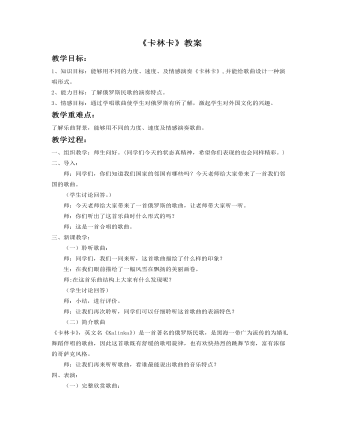
《卡林卡》教案
教学过程:一、组织教学:师生问好。(同学们今天的状态真精神,希望你们表现的也会同样精彩。)二、导入:师:同学们,你们知道我们国家的邻国有哪些吗?今天老师给大家带来了一首我们邻国的歌曲。(学生讨论回答。)师:今天老师给大家带来了一首俄罗斯的歌曲,让老师带大家听一听。师:你们听出了这首乐曲时什么形式的吗? 师:这是一首合唱的歌曲。三、新课教学: (一)聆听歌曲: 师:同学们,我们一同来听,这首歌曲描绘了什么样的印象? 生:在我们眼前描绘了一幅风雪在飘扬的美丽画卷。师:在这首乐曲结构上大家有什么发现呢?(学生讨论回答) 师:小结,进行评价。 师:让我们再次聆听,同学们可以仔细聆听这首歌曲的表演特色?
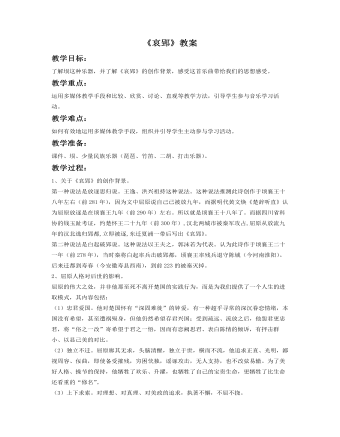
《哀郢》教案
关于《哀郢》的创作背景。第一种说法是放逐思归说。王逸、洪兴祖持这种说法。这种说法推测此诗创作于顷襄王十八年左右(前281年),因为文中屈原说自己已被放九年,而据明代黄文焕《楚辞听直》认为屈原放逐是在顷襄王九年(前290年)左右。所以就是顷襄王十八年了。而据四川省科协的钱玉趾考证,约楚怀王二十九年(前300年),汉北两城市被秦军攻占,屈原从放流九年的汉北逃归郢都,立即被逐,东迁夏浦一带后写出《哀郢》。第二种说法是白起破郢说。这种说法以王夫之,郭沫若为代表。认为此诗作于顷襄王二十一年(前278年),当时秦将白起率兵击破郢都,顷襄王率残兵退守陈城(今河南淮阳)。后来迁都到寿春(今安徽寿县西南),到前223的被秦灭掉。
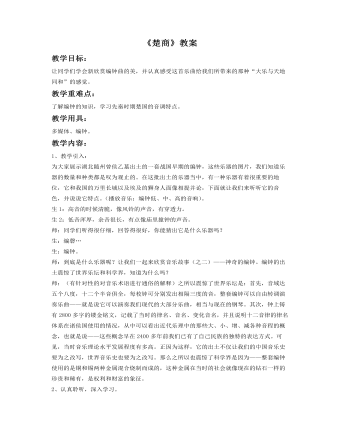
《楚商》教案
之所以震惊了世界乐坛是:首先,音域达五个八度,十二个半音俱全,每枚钟可分别发出相隔三度的音,整套编钟可以自由转调演奏乐曲——就是说它可以演奏我们现代的大部分乐曲,相当与现在的钢琴。其次,钟上铸有2800多字的镂金铭文,记载了当时的律名、音名、变化音名,并且说明十二音律的律名体系在诸侯国使用的情况,从中可以看出近代乐理中的那些大、小、增、减各种音程的概念,也就是说——这些概念早在2400多年前我们已有了自己民族的独特的表达方式。可见,当时音乐理论水平发展程度有多高。正因为这样,它的出土不仅让我们的中国音乐史要为之改写,世界音乐史也要为之改写。那么之所以也震惊了科学界是因为——整套编钟使用的是铜和锡两种金属混合烧制而成的,这种金属在当时的社会就像现在的钻石一样的珍贵和稀有,是权利和财富的象征。
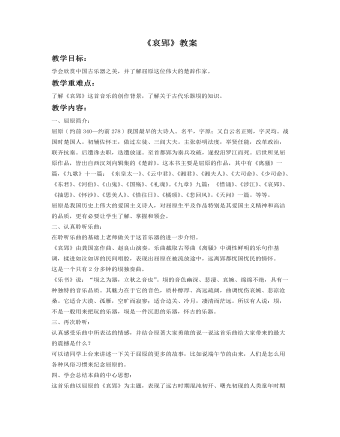
《哀郢》教案
屈原 ( 约前340—约前278 ) 我国最早的大诗人。名平,字原;又自云名正则,字灵均。战国时楚国人。初辅佐怀王,做过左徒、三闾大夫。主张彰明法度,举贤任能,改革政治,联齐抗秦。后遭谗去职,迭遭放逐。至首都郢为秦兵攻破,遂投汨罗江而死。后世所见屈原作品,皆出自西汉刘向辑集的《楚辞》。这本书主要是屈原的作品,其中有《离骚》一篇,《九歌》十一篇:《东皇太一》、《云中君》、《湘君》、《湘夫人》、《大司命》、《少司命》、《东君》、《河伯》、《山鬼》、《国殇》、《礼魂》。《九章》九篇:《惜诵》、《涉江》、《哀郢》、《抽思》、《怀沙》、《思美人》、《惜往日》、《橘颂》、《悲回风》。《天问》一篇。等等。屈原是我国历史上伟大的爱国主义诗人,对屈原生平及作品特别是其爱国主义精神和高洁的品质,更有必要让学生了解、掌握和领会。
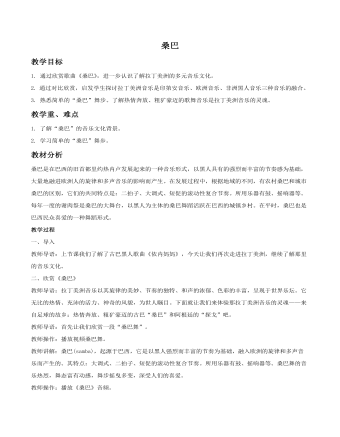
《桑巴》教案
教学过程一、导入教师导语:上节课我们了解了古巴黑人歌曲《依内妈妈》,今天让我们再次走进拉丁美洲,继续了解那里的音乐文化。二、欣赏《桑巴》教师导语:拉丁美洲音乐以其旋律的美妙、节奏的独特、和声的浓郁、色彩的丰富,呈现于世界乐坛。它无比的热情、充沛的活力、神奇的风貌,为世人瞩目。下面就让我们来体验那拉丁美洲音乐的灵魂——来自足球的故乡:热情奔放、粗犷豪迈的古巴“桑巴”和阿根廷的“探戈”吧。教师导语:首先让我们欣赏一段“桑巴舞”。教师操作:播放视频桑巴舞。教师讲解:桑巴(samba),起源于巴西,它是以黑人强烈而丰富的节奏为基础,融入欧洲的旋律和多声音乐而产生的。其特点:大调式、二拍子、短促的滚动性复合节奏。所用乐器有鼓、摇响器等。桑巴舞的音乐热烈,舞态富有动感,舞步摇曳多变,深受人们的喜爱。 教师操作:播放《桑巴》音频。教师导语:让我们大家一起随着音乐跳起来吧!学生活动:边听音乐边拍打节奏,学做简单的“桑巴”舞蹈动作,并随音乐跳舞。三、课堂小结本节课通过欣赏乐曲《桑巴》,同学们进一步的了解认识了拉丁美洲的多元音乐文化。又通过对比欣赏,启发学生探讨了拉丁美洲音乐是印第安音乐、欧洲音乐、非洲黑人音乐三种音乐的融合。
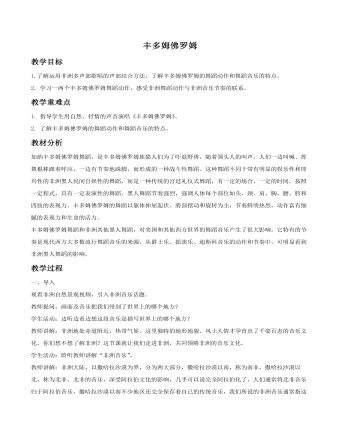
《丰多姆佛罗姆》教案
教学过程一、导入观看非洲自然景观视频,引入非洲音乐话题。教师提问:画面及音乐把我们带到了世界上的哪个地方?学生活动:边听边看边想这段音乐是描写世界上的哪个地方?教师讲解:非洲地处赤道附近,热带气候。这里独特的地形地貌、风土人情才孕育出了千姿百态的音乐文化。你们想不想了解非洲?这节课就让我们走进非洲,共同领略非洲的音乐文化。学生活动:聆听教师讲解“非洲音乐”。教师讲解:非洲大陆,以撒哈拉沙漠为界,分为两大部分,撒哈拉沙漠以南,称为南非,撒哈拉沙漠以北,称为北非。北非的音乐,深受阿拉伯文化的影响,几乎可以说完全阿拉伯化了,人们通常将北非音乐归于阿拉伯音乐,撒哈拉沙漠以南不少地区还完全保存着自己的传统音乐,我们所说的非洲音乐通常指这些地区各种土著黑人的传统音乐。二、学唱歌曲《丰多姆佛罗姆》1.教师播放歌曲《丰多姆佛罗姆》,提问:这首歌曲的情绪如何?表达了怎样的思想感情?学生活动:完整地欣赏,思考乐曲的情绪和表达的思想感情。(抒情性的音乐情绪,表达对家乡的思念之情。)2.介绍作品。教师讲解:这是一首典型的非洲民歌。歌曲以生动的语言叙述了黑人战斗的情境。

初中历史与社会人教版九年级下册《地球一小时 活动》教材教案
地球一小时(Earth Hour)是世界自然基金会(WWF)应对全球气候变化所提出的一项倡议,希望家庭及商界用户关上不必要的电灯及耗电产品一小时。来表明他们对应对气候变化行动的支持。过量二氧化碳排放导致的气候变化目前已经极大地威胁到地球上人类的生存。公众只有通过改变全球民众对于二氧化碳排放的态度,才能减轻这一威胁对世界造成的影响。地球一小时在3月的最后一个星期六20:30~21:30期间熄灯。活动由来:“地球1小时”也称“关灯一小时”,是世界自然基金会在2007年向全球发出的一项倡议:呼吁个人、社区、企业和政府在每年三月最后一个星期六20:30~21:30期间熄灯1小时,以此来激发人们对保护地球的责任感,以及对气候变化等环境问题的思考,表明对全球共同抵御气候变暖行动的支持。这是一项全球性的活动,世界自然基金会于2007年首次在悉尼倡导之后,以惊人的速度席卷全球,大家都来参加这个活动。[1] “地球1小时”活动首次于2007年3月31日在澳大利亚的悉尼展开,一下子吸引了超过220万悉尼家庭和企业参加;随后,该活动以惊人的速度迅速席卷全球。在2008年,WWF(中国)对外联络处透露,全球已经有超过80个国家、大约1000座城市加入活动。2013年,包括悉尼歌剧院、帝国大厦、东京塔、迪拜塔、白金汉宫在内的各国标志性建筑也在当地时间晚八点半熄灯一小时。[2] ,其中包括巴勒斯坦、法属圭亚那、加拉帕戈斯群岛、卢旺达、圣赫勒那岛、苏里南、突尼斯等首次参与“地球一小时”的国家和地区。在中国,北京鸟巢、水立方、世贸天阶等标志性建筑同时熄灯,同一时段,从上海东方明珠到武汉黄鹤楼,从台北101到香港天际100观景台,中国各地多个标志性建筑均熄灯一小时,全国共有127个城市加入“地球一小时”活动。

人教部编版语文九年级上册任务二诗歌朗诵(2)教案
1.主持人致开幕词。2.参赛选手按时到场、抽签。3.主持人介绍比赛规则和评分细则。(1)分年级比赛,各年级同时进行,并根据相同的评分标准来评奖。(2)比赛规则:①参赛选手须使用普通话,尽可能脱稿朗诵,并富有感情色彩,辅以丰富的肢体语言;②每位选手比赛时间限定在3-5分钟,如果超时或不足,评委将适当扣分;③比赛顺序由抽签决定,中途不得变更顺序,比赛需紧凑进行,选手上场迟到2分钟以上则视为弃权;④参赛选手须严格遵守比赛规则,在比赛过程中若有异议,由评委会裁定。4.主持人报幕,请选手上台朗诵。5.比赛结束后,邀请评委上台发言,工作人员进行统分。6.主持人宣布比赛结果,请嘉宾为获奖者颁奖。7.主持人宣布本次比赛结束,请嘉宾和评委退场。四、课后巩固,布置作业1.布置学生课后搜集艾青的一篇经典的、适合个人朗诵的诗歌,在课下作朗诵练习。
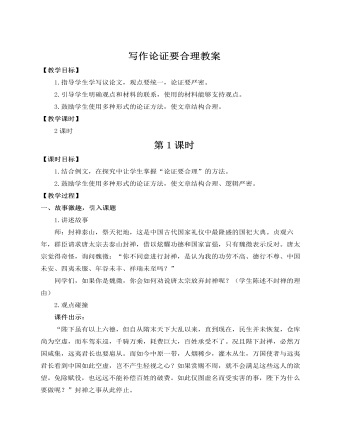
人教部编版语文九年级上册写作论证要合理教案
当然,知足常乐者,并不是说这个人要安于现状,没有追求,没有理想,而是要懂得适可而止,懂得取舍,懂得放弃,毕竟人的欲望是无限的。如《我的叔叔于勒》讲述了这样一个故事:年轻时,于勒大肆挥霍,被看成是“祸水”,落得被扫地出门的地步。既至美洲,赚了小钱,两年后又发了大财,成为大家的“福星”。菲利普一家渴盼有钱的于勒归来,二姐也因此找到了未婚夫,一家人都很高兴,出国到哲尔赛岛旅行。他们在船上却见到一个酷似于勒的穷苦的卖牡蛎的人,菲利普先生在船长那里得到了可怕的印证。不但发财的梦想化为乌有,进入上流社会的美梦成为泡影,而且眼下二女儿的婚事也岌岌可危,最后全家不动声色地改乘另一艘海轮回来。菲利普夫妇对于勒的态度完全建立在金钱之上,因此,他们的人生注定不会常乐。被称为“古今隐逸诗人之宗”的陶渊明,在乡野山林中,找到了人生乐趣。大名鼎鼎的诗仙李白,在不得志之时,仍有“天生我材必有用,千金散尽还复来”的达观之句。被林语堂先生称为“无可救药的乐天派”的苏东坡虽一生坎坷,仍对生命和生活充满热爱。所以,知足者,常乐也。人们常说:“人生不如意事十之八九。”那么我们不妨“常想一二”。拥有一颗乐观的心,才是我们成功的关键。
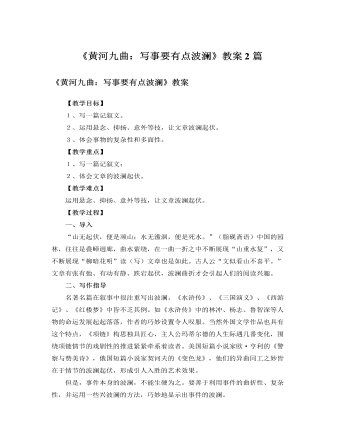
人教版高中语文必修1《黄河九曲:写事要有点波澜》教案2篇
1.悬念法悬念法又称关子。它是作者为了激发那种“紧张与期待的心理活动”,在行文中有意采取的一种积极而有效的手段。这种手段包括“设悬”和“解悬”两方面。所谓 “设悬”就是设置悬念,即在情节发生发展的关键时刻或人物命运攸关的重要关头,叙述戛然而止,转叙他事。从而引起读者强烈的寻根问底的兴趣。所谓“解悬” 也叫“释悬”,就是指在情节发展的特定阶段,通过矛盾的解决,揭示事情原委和人物命运的结局,使读者的期待心理得以满足。如《驿路梨花》,当人们正为露宿而发愁时出现了一间神秘的小屋,小屋的主人是谁呢?猜想间,有人来了,但也不是屋子主人,那小屋子的主人是谁呢?终于知道了小屋是解放军盖的,但为什么要盖这间小屋呢?这样“设悬——释悬——带出新悬念”,环环相扣、层层递进,使文章韵味无穷。

人教版新目标初中英语九年级上册Teenagers should be allowed to choose their own clothes教案2篇
Step 1 Greeting Greet the class and check the homeworkStep 2 A duty report The S on duty gives a report on the rules in his home and lead in 3a “Sun Fei’s and Wu Yu’s rules” Step 3 ReadingSs read the conversation and write the two girls’ rules in the chart. Check the answers.Get Ss to read after the tape and then read aloud by themselves. Then, T explains the language points.Step 4 Pairwork 3bRole play. Use the information in chart to practice with the conversation in 3a covered. They can look at the sample conversation in the right box.Step 5 Task 2 “Who’s the best reporter?”Make a survey by asking any 5 students the questions in the chart in activity 4. Then give out a report about it. See who is the best reporter? And the best reporter will get a nice ball-pen.Step 6 Summary and homework:Write out the report in your exercise-books.Period ThreeStep 1 Greeting and a duty reportThe S gives a duty report talking about his experience of being late for school. Lead in the question “Do you ever get to school late? How often do you get to school late? Always, usually, sometimes, or never?Step 2 1a Get Ss to finish writing.Step 3 Pairwork 1b Get Ss to talk about their answers with their partners using the sample conversation in the box on the right.Step 4 Listening practice2a Lead-in: What will happen if you get to school late? What about Peter? Let’s listen to a conversation between Peter and his father. Get Ss to finish 2a (As usual, for the first time, Ss only listen.) Check the answers.

人教版新目标初中英语九年级上册I like music that I can dance to教案
教学目标: 1. Express preferences2. Talk about one’s likes and dislikes and the reasons3. Learn to express one’s opinions 4. Learn to write a reply 语言功能: 1) Talk about one’s preferences, using t he relative clause2) Talk about people’s likes and dislikes and the reasons3) Talk about opinions语言结构: Relative clauses with that and who语言目标:What kind of music do you like?I like music that I can sing along with.I love singers who write their own music.We prefer music that has great lyric.重点词汇及短语:heart, photography, interest, class, whatever, miss, okay, expect, sweet, taste, itself, laboratory, cancer, increase, biscuit, main, care, prefer… to…, remind somebody of …, dance to, sing along with, be sure to, interest somebody, make somebody adj., to be honest, suit somebody, on display, catch up教学重难点:What do other people think of the different kinds of things? How to express one’s opinions? 学习方式:讨论,合作学习情感目标:通过本单元的学习,能提高学生的艺术鉴赏能力和审美情趣,并引导学生养成健康的饮食习惯。课时安排5课时第一课时:Section A: 1a-2c第二课时:Section A : 3a-4第三课时:Section B:1-2c, Self check2第四课时:Section B: 3a-4, Self check1第五课时:Self check ReadingI like music that I can dance to.

人教版新目标初中英语九年级上册I used to be afraid of the dark教案
内容提示1.本单元主要内容是学会used to结构。Used to +动词原形表示过去经常、以前常常,只用于过去式中,用来表示现在已不存在的习惯或状态。例如:They used to play football together.他们过去常在一起蹋足球。(现在不在一起踢了)2.used to的疑问形式和否定形式为Did you use to…?和I didn’t use to… 也可以用Used you to…?和I used not to…但现在多使用前者。例如:Did you used to swim in the river? 你过去常在河里游泳吗?I didn’t use to play the piano. 我以前并不经常弹钢琴。教学目标一、学习目标(Language Goal) 1.学会陈述自己过去常做的事情。2.学会陈述自己过去的爱好等。3.能够表达自己现在和过去在外表、性格、娱乐等方面的变化。4.能够表达朋友、家人等现在和过去的变化。二、语言结构(Language Structures) 1.I used to be short when I was young. 我年轻时个子很矮。 2. —Did you use to have straight hair? 你过去是直发吗?—Yes, I did. 是的。 3. —Did you use to play the piano? 你过去弹钢琴吗?—No, I didn’t. 不,我不弹。 4.I used to be afraid of dark. 我过去害怕黑暗。 5.I’m terrified of the snakes. 我害怕蛇。

人教版新目标初中英语九年级下册By the time I got outside, the bus had already left教案
Ⅰ. Teaching Aims and Demands1. Knowledge Objects(1) Key Vocabularyoversleep(2) Target LanguageWhat happened?I overslept. And by the time I got up, my brother had already gotten in the shower.2. Ability Objects(1) Teach the students to use the new words.(2) Train the students to narrate past events with the Past Perfect Tense.(3) Train the students' listening and speaking skills with the target language.3. Moral ObjectIt’s a good habit to go to bed early in the evening and get up early in the morning. So you’ll never be in a hurry in the morning.Ⅱ. Teaching Key Points1. Key Vocabularyoversleep2. Target LanguageNarrate past events with the Past Perfect TenseⅢ. Teaching Difficult Points1. Train the students to narrate past events with the Past Perfect Tense.2. Train the students to understand the target language in spoken conversation.Ⅳ. Teaching Methods1. Thinking of examples from the students' real lives.2. Making sentences by looking at the pictures.Ⅴ. Teaching AidA tape recorderⅥ. Teaching ProceduresStep I Revision1. Revise the language points in Unit 8.Ask some questions like this: What volunteer work would you like to do?Help the students to answer, I’d like to…/I love to…/I hope to2. Practice the dialogue in Activity 3c on page 62 again. Get students to role play the similar dialogues with the following.

人教版新目标初中英语九年级上册It must belong to Carla教案
一、Section A该部分有4个模块。第一模块围绕Whose volleyball is this? 这一话题展开思维( 1a)、听力(1b)、口语( 1c)训练;第二模块围绕上一模块中的话题进行听力( 2a-2b)、口语训练( 2c);第三模块继续围绕前两个模块中的“making inferences”展开训练。训练形式为阅读排序( 3a)和两人问答(3b);第四模块仍就上一话题展开讨论。二、Section B该部分有4个模块。第一模块要求根据图画和所提供的单词写出合理的句子;第二模块在听力( 2a-2b)和分角色口语训练( 2c)的基础上,继续进行“推测”训练; 第三模块围绕“Strange events in Bell Tower neighborhood”这一话题展开阅读( 3a)和写作(3b -3c)训练;第四模块以dream为话题展开小组活动。三、Self Check该部分有3个模块。第一模块以填空形式对所学词汇进行训练;第二模块就8个谚语展开阅读和讨论。

人教版新目标初中英语九年级上册Where would you like to visit教案2篇
The First PeriodⅠ.Teaching Aims and DemandsKnowledge Objects(1) Key Vocabularytiring, educational, fascinating, thrilling, peaceful, exotic, trek, jungle, take it easy, explore, historic, site(2) Target LanguageWhere would you like to go on vacation?I’d like to trek through the jungle, because I like exciting vacations.2. Ability Objects(1)Train students to talk about places they would like to visit with the target language.(2)Train students to describe vacations with different adjectives.(3)Train students' listening skill.3. Moral Object,It′s more interesting to go on vacating somewhere instead of staying at home.Ⅱ. Teaching Key Points1. Key Vocabularytiring, educational, fascinating, thrilling, peaceful, exotic, trek, jungle, take it easy, explore, historic, site2. Target LanguageTalk about different places with the target language.Ⅲ. Teaching Difficult Points1. Describe vacations with different adjectives.2. Talk about different places with the target language.Ⅳ. Teaching Methods1. Teaching by illumination2. Teaching by doing chain drills3. Teaching by pairworkⅤ. Teaching Aids1. A tape recorder2. Some pictures of different places with famous views

人教版新目标初中英语九年级下册Rainy days make me sad教案
1. 教材分析本单元以how do things affect you?为话题, 从颜色、天气、音乐、广告、产品等方面谈论了外界事物如何影响人的心情。要求学生掌握表达某物或某事给人带来的感觉、看法或影响等。共设计了四个部分的内容:Section A 该部分有4个模块:第一模块围绕Which restaurant would you like to go to?这一话题展开思维(1a)、听力(1b)、口语(1c)训练;第二模块围绕How does music affect you? 进行听力(2a-2b)、口语训练(2c);第三模块继续围绕how do colors in the restaurant affect you这一话题展开训练,训练形式为阅读和问题体验(3a)和小组活动(3b);第四模块仍就How do things affect you这一话题以调查的形式展开讨论。Section B该部分有4个模块:第一模块围绕产品广告对人们的影响这一话题以“配对”(1a)与“列举”(1b)两种形式展开训练;第二模块继续围绕How do things affect you? 进行听力(2a-2b)、口语对话训练(2c);第三模块围绕“Advertising”这一话题展开阅读(3a-3b)和写作(3c)训练;第四模块围绕How posters affect you这一话题以口语训练形式展开小组活动。

人教版新目标初中英语九年级下册Could you please tell me where the restrooms are教案
Step Ⅰ RevisionCheck homework. Ask a few students to read the article in 3a.Then ask a few students to read their guides.Step Ⅱ Part 1Look at the words in the box. Ask a student to read them. Make sure the students understand the meaning of the words. You are to fill in the blanks with the words. In some cases, students may need to use another form of the word, for example adjusting for tense or subject/ verb agreement.Ask students to fill in the blanks on their own.Check the answers. Step ⅢPart 2Go through the instructions with the class.Look at the example with the students.Ask students what the answer would be.Ask a student to read the question and answer it.Excuse me, could you tell me where the bank is, please?The bank is across the street from the shopping malt.Get students to complete the work in pairs.Check the answers. Ask a few students to read their questions.Step Ⅳ Just for Fun!Ask all the students to read the conversation. Ask: What is funny about this cartoon? Help students to explain. A Martian is a person from the planet Mars.There is no such thing as Martian food on Earth, and the clerk looks silly because he is trying to think of where there is a Martian restaurant.Invite some pairs of students to present this conversation to the rest of the class.Step Ⅴ Summary and HomeworkIn this class, we’ve done much writing practice using the key vocabulary words and the target language presented in this unit. After class, please finish the questions in 2 in your exercise books. Then finish the exercises on pages 47~48 of the workbook as well.The Seventh Period Ⅰ Teaching Aims and Demands1. Knowledge Objects(1) Key Vocabularyimage, adventure, jealousy, hero, crime, journey, brave, no longer, show interest in, take it easy, become interested in, plain looks(2)Text:Grown-ups like cartoons, too.2. Ability Objects(1) Fast-reading to get a general idea of the text.(2) Careful-reading to get the detailed information in the text.

人教版新目标初中英语九年级下册I’ll help clean up the city parks教案
Talk about offering help (P60)I’ll help clean up the city parks.A: I’d like to work ...B: You could help ...Talk about ways to tell people about the Clean-Up Day (P61)We need to ...We can’t ...I’ll ...Talk about the work the volunteers do (P62)These three students all volunteer their time to help other people.Somebody loves to ... / helps ... / plans to ... / wants to ...A: What do you like doing?B: I like ... A: What kind of volunteer work do you think I could do?B: You could ...1. 重点词汇advertisement, fix, repair, pleasure, blind, deaf, shut, carry, specially, fetch2. 认读词汇hunger, homeless, cheer, clean-up, sign, establish, major, commitment, elementary, veterinarian, coach, similar, call-in, strategy, disabled, organization, unable, support, appreciate, donation, part of speech, pronoun, adverb, preposition, conjunction, donate, Jimmy, Sally3. 词组clean up, cheer up, give out, put off, set up, think up, take after, fix up, give away, put up, hand out, work out, at once

